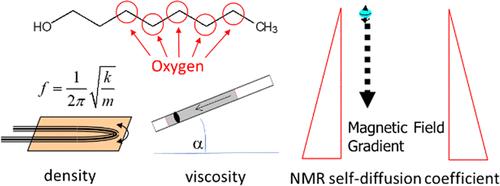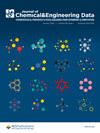辛醇及相关醚醇的密度、粘度和自扩散系数
IF 2
3区 工程技术
Q3 CHEMISTRY, MULTIDISCIPLINARY
引用次数: 0
摘要
报告了辛烷-1-醇和相关醚醇 2-戊氧基乙烷-1-醇、3-丁氧基丙烷-1-醇、4-丙氧基丁烷-1-醇、5-乙氧基戊烷-1-醇和 6-甲氧基己烷-1-醇的密度、粘度和自扩散系数,温度范围为 298.15 至 359.15 K。这些新数据揭示了醚醇分子结构中醚分子的存在和位置对结构-性质关系的影响。与辛烷-1-醇相比,醚分子的存在增加了分子间氢键的相互作用,导致密度升高。而那些参与分子内氢键作用的醚辛醇的密度增加则不太明显。至于醚分子对动力学的影响,与辛-1-醇相比,醚醇的影响通常更快,这表明醚氧和羟基氢之间的氢键作用比两个羟基之间的氢键作用要弱。阿伦尼乌斯分析法得出的所有醇类平移运动的活化能均高于动量传递的活化能。这些活化障碍在不同的醚醇中还有更多细微差别。这些差异在自扩散系数和粘度(Dη)的数学乘积中被抵消。我们还研究了水杂质对所研究特性的影响,发现水杂质会导致所有醇类的密度略有增加。辛烷-1-醇和 2-戊氧基乙烷-1-醇的粘度会降低,而其他可发生分子内氢键作用的醚醇的粘度则会升高。本文章由计算机程序翻译,如有差异,请以英文原文为准。

Densities, Viscosities, and Self-Diffusion Coefficients of Octan-1-ol and Related Ether-Alcohols
Density, viscosity, and self-diffusion coefficients are reported for octan-1-ol and the related ether-alcohols 2-pentoxy-ethan-1-ol, 3-butoxypropan-1-ol, 4-propoxybutan-1-ol, 5-ethoxypentan-1-ol, and 6-methoxyhexan-1-ol covering temperature ranges from 298.15 to 359.15 K. These new data reveal structure–property relationships affected by the presence and the position of the ether moiety in the molecular structure of the ether-alcohols. Compared to octan-1-ol, the presence of the ether moiety causes an increase in intermolecular hydrogen bonding interactions, resulting in higher densities. The increase in density is less pronounced for those ether-octanols that engage in intramolecular hydrogen bonding. As for the effects of the ether moiety on the dynamics, these are generally faster for the ether-alcohols compared to octan-1-ol, suggesting that hydrogen bonding between ether oxygen and hydroxy hydrogen is weaker compared to hydrogen bonding between two hydroxy groups. The activation energies obtained from an Arrhenius analysis are higher for translational motion than for momentum transfer for all alcohols. There are additional finer details across the ether alcohols for these activation barriers. These differences cancel out for the mathematical product of self-diffusion coefficient and viscosity (Dη). The effect of water impurities on the studied properties was also investigated and found to lead to small increases in densities for all alcohols. Viscosities decrease for octan-1-ol and 2-pentoxyethan-1-ol but increase for the other ether-alcohols that can engage in intramolecular hydrogen bonding.
求助全文
通过发布文献求助,成功后即可免费获取论文全文。
去求助
来源期刊

Journal of Chemical & Engineering Data
工程技术-工程:化工
CiteScore
5.20
自引率
19.20%
发文量
324
审稿时长
2.2 months
期刊介绍:
The Journal of Chemical & Engineering Data is a monthly journal devoted to the publication of data obtained from both experiment and computation, which are viewed as complementary. It is the only American Chemical Society journal primarily concerned with articles containing data on the phase behavior and the physical, thermodynamic, and transport properties of well-defined materials, including complex mixtures of known compositions. While environmental and biological samples are of interest, their compositions must be known and reproducible. As a result, adsorption on natural product materials does not generally fit within the scope of Journal of Chemical & Engineering Data.
 求助内容:
求助内容: 应助结果提醒方式:
应助结果提醒方式:


